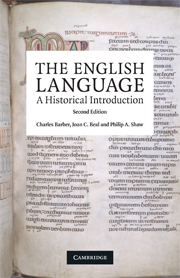Book contents
- Frontmatter
- Contents
- List of figures
- Preface to the second edition
- Preface to the first edition
- Map showing the counties of England
- 1 What is language?
- 2 The flux of language
- 3 The Indo-European languages
- 4 The Germanic languages
- 5 Old English
- 6 Norsemen and Normans
- 7 Middle English
- 8 Early Modern English
- 9 Late Modern English
- 10 English as a world language
- 11 English today and tomorrow
- Notes and suggestions for further reading
- Bibliography
- Index
7 - Middle English
- Frontmatter
- Contents
- List of figures
- Preface to the second edition
- Preface to the first edition
- Map showing the counties of England
- 1 What is language?
- 2 The flux of language
- 3 The Indo-European languages
- 4 The Germanic languages
- 5 Old English
- 6 Norsemen and Normans
- 7 Middle English
- 8 Early Modern English
- 9 Late Modern English
- 10 English as a world language
- 11 English today and tomorrow
- Notes and suggestions for further reading
- Bibliography
- Index
Summary
Old English did not disappear overnight at the Norman Conquest, nor did it immediately stop being written, for the West Saxon literary tradition was continued for a time in some of the great monasteries. But, in the years following the Conquest, changes which had already begun to show themselves in pre-Conquest Old English continued, and in less than a century we can say that the Old English period is over, and that Middle English has begun.
The Conquest, in fact, made the change from Old English to Middle English look more sudden than it really was, by introducing new spelling conventions. An established literary language like late West Saxon tends to be conservative in its spelling: changes occur in pronunciation, but the scribes often go on writing the words in the traditional way. But the Norman scribes disregarded traditional English spelling, and simply spelt the language as they heard it, using many of the conventions of Norman French. Consequently, many changes that had not been reflected in OE spelling, or which had appeared only in occasional spellings, now emerged clearly.
New spelling conventions
Quite apart from revealing hidden changes, the new orthography gave English writings quite a new look. A number of new consonant symbols were introduced. A new symbol g was introduced for the stops represented by OE ʒ, and the OE symbol was retained only for the fricatives.
- Type
- Chapter
- Information
- The English LanguageA Historical Introduction, pp. 161 - 184Publisher: Cambridge University PressPrint publication year: 2009

